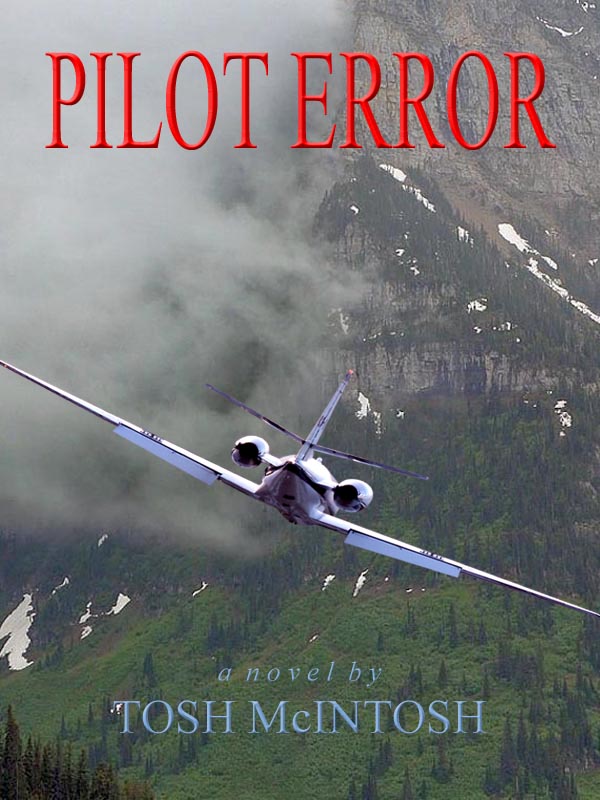This came to me from Bill Schwoeble, a friend and fellow aviator. The account is abridged and edited slightly from the original source, Aviation Week & Space Technology: “Contrails.” I’m publishing it as a visitor story not because the author knows me, has visited my website, or ever will. But it’s well written and effectively puts readers in the cockpit (and out of it) in chilling fashion. Sharing it seems entirely appropriate to one of my original intentions for the site.
 The author, USAF General Merrill A. (Tony) McPeak, flew F-100, F-104, F-4, F-111, F-15 and F-16 fighters, including 269 combat missions in Vietnam as an attack pilot and high-speed forward air controller (FAC). He commanded the Misty FACs (F-100s), 20th Fighter Wing, Twelfth Air Force and Pacific Air Command, and completed his career as the 14th USAF Chief of Staff. He participated in nearly 200 airshows as a solo pilot for the Thunderbirds, and this story from that time is undoubtedly the most hair-raising event of his long and distinguished career.
The author, USAF General Merrill A. (Tony) McPeak, flew F-100, F-104, F-4, F-111, F-15 and F-16 fighters, including 269 combat missions in Vietnam as an attack pilot and high-speed forward air controller (FAC). He commanded the Misty FACs (F-100s), 20th Fighter Wing, Twelfth Air Force and Pacific Air Command, and completed his career as the 14th USAF Chief of Staff. He participated in nearly 200 airshows as a solo pilot for the Thunderbirds, and this story from that time is undoubtedly the most hair-raising event of his long and distinguished career.
The West Texas border town of Del Rio was used several times as a movie set. Like Lubbock, where I took my USAF Undergraduate Pilot Training, it’s windy more than not, and the weather tends toward extremes. The large U.S. Air Force Base 6 miles east of town was named after Jack T. Laughlin, a B-17 pilot and Del Rio native killed over Java within a few weeks of the Japanese attack on Pearl Harbor. General McPeak’s account begins with the arrival of the Thunderbirds at Laughlin. Enjoy.
Our Thunderbirds Team is scheduled for an air show to honor 60 or so lieutenants graduating from pilot training. We go through the standard pre-show routine. Lead and 5 do their show-line survey, while the rest of us make the rounds of hospital and school visits and give interviews. Next day, proud parents watch as new pilots pin on wings. At noon, we brief at Base Ops. As usual, an “inspection team” comprising base and local dignitaries joins us for a photo session before we step to the jets.
 The film “Bandolero” is in production near the base, and its stars, Jimmy Stewart and Raquel Welch, show up in the inspection team. Jimmy Stewart is a USAF Reserve brigadier general, a founder of the Air Force Association and a big hero to all of us. Raquel Welch is . . . well, she’s Raquel Welch.
The film “Bandolero” is in production near the base, and its stars, Jimmy Stewart and Raquel Welch, show up in the inspection team. Jimmy Stewart is a USAF Reserve brigadier general, a founder of the Air Force Association and a big hero to all of us. Raquel Welch is . . . well, she’s Raquel Welch.
We’re wearing white show suits, my least-favorite outfit, and we look like Good Humor Ice Cream men. Plus, I work hard during the solo demonstration and sweat soaks my collar. This wouldn’t matter much, except we do a lot of taxiing in-trail. With only 6 feet between the end of my pitot and No. 5’s tailpipe, I take a load of engine soot in my cockpit. Soot clings to any damp cloth, leaving a noticeable “ring around the collar” when wearing white. Once we have taxied away from the crowd, I perform my usual routine and roll the collar inside-out to catch the soot. After the show, I’ll roll it back out and the chimney-black will be hidden from sight.
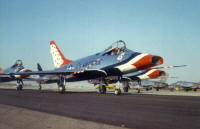 We taxi short of the runway for a quick pre-takeoff inspection by a couple of our maintenance troops. As No. 6, I’m flying F-100D serial number 55-3520. And thus far it has been a good bird.
We taxi short of the runway for a quick pre-takeoff inspection by a couple of our maintenance troops. As No. 6, I’m flying F-100D serial number 55-3520. And thus far it has been a good bird.
We take the runway . . . the four-aircraft Diamond fingertip up ahead . . . with Bobby Beckel and me in an element, 500 feet back. The Diamond releases brakes at precisely 1430. Bobby and I run up engines, my stomach tightening against the surge of isolation and exhilaration that comes before every air show takeoff.
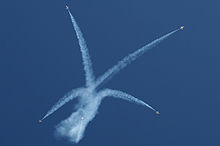 By this time in the season, the Team is really “clicking.” We have a lot of shows under our belt and we know what we are able to do as a team. Twenty-one minutes into the event, it’s going well with a nice cadence and rhythm. Then we approach the climax, the signature “Bomb Burst.”
By this time in the season, the Team is really “clicking.” We have a lot of shows under our belt and we know what we are able to do as a team. Twenty-one minutes into the event, it’s going well with a nice cadence and rhythm. Then we approach the climax, the signature “Bomb Burst.”
My job is to put “pigtails” through the separating formation, doing unloaded G force, max-rate rolls in the vertical. Even a few vertical rolls require establishing a perfectly vertical “up-line.” More than a few vertical rolls also requires starting with a ton of airspeed. I grab for altitude as the Diamond pirouettes into their entry for the final maneuver. And at just the right moment, concealed behind their trailing smoke, I dive below.
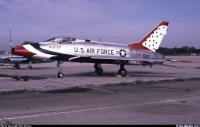 The Thunderbirds had switched to the F-100 in 1956, making us the world’s first afterburner-equipped, supersonic-capable flying demonstration team. Airspeed builds fast in these birds, and I have to be mindful of a hard-and-fast rule: don’t go supersonic during the airshow. No “booming” the crowd. So, I want to be subsonic. But just barely . . . let’s say . . . MACH 00000.99
The Thunderbirds had switched to the F-100 in 1956, making us the world’s first afterburner-equipped, supersonic-capable flying demonstration team. Airspeed builds fast in these birds, and I have to be mindful of a hard-and-fast rule: don’t go supersonic during the airshow. No “booming” the crowd. So, I want to be subsonic. But just barely . . . let’s say . . . MACH 00000.99
Other than exceeding the speed of sound, the biggest mistake I can make is to be early. The Diamond is about to break in all four directions, and if I get there too soon, I don’t have any exit strategy. That’s a bad scenario, indeed.
 Today, my timing looks good. If I get it right, I’ll hit the apex of the Bomb Burst exactly 5 seconds after the Diamond separates, snap the throttle out of burner to get the smoke going while perfectly vertical. And moving very fast. As the Diamond pilots track away from one another to the four points of the compass, I’ll lay in those lazy, lovely curvy white pigtails. Then I’ll get the smoke off and figure out how not to do a messy slow-speed vertical recovery.
Today, my timing looks good. If I get it right, I’ll hit the apex of the Bomb Burst exactly 5 seconds after the Diamond separates, snap the throttle out of burner to get the smoke going while perfectly vertical. And moving very fast. As the Diamond pilots track away from one another to the four points of the compass, I’ll lay in those lazy, lovely curvy white pigtails. Then I’ll get the smoke off and figure out how not to do a messy slow-speed vertical recovery.
But at Del Rio, it doesn’t turn out right. As I light the burner and start an aggressive 6.5 G pull up to the vertical, the aircraft explodes!
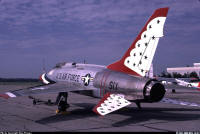 Now, F-100 pilots are accustomed to loud noises. The afterburner can “bang” pretty hard when it lights off. It’s also fairly common for the engine compressor to stall, forcing a violent cough of rejected air back up the intake. Sometimes flame belches out the long oval nose — which will definitely wake you up at night. And the shock can kick your feet off the rudder pedals. Any F-100 pilot who hears a loud BANG! automatically thinks: “compressor stall,” and unloads the G’s to get air traveling down the intake in the right direction.
Now, F-100 pilots are accustomed to loud noises. The afterburner can “bang” pretty hard when it lights off. It’s also fairly common for the engine compressor to stall, forcing a violent cough of rejected air back up the intake. Sometimes flame belches out the long oval nose — which will definitely wake you up at night. And the shock can kick your feet off the rudder pedals. Any F-100 pilot who hears a loud BANG! automatically thinks: “compressor stall,” and unloads the G’s to get air traveling down the intake in the right direction.
 Instinctively in response to the explosion, I relax stick-pressure to unload Gs. And by now, I’m fully committed into a fast-forward mental exercise where seasons compress into seconds and the tree leaves can change color while you are looking at them. As I move the stick forward a bit to unload, my situational awareness clicks in: “That’s no compressor stall!”
Instinctively in response to the explosion, I relax stick-pressure to unload Gs. And by now, I’m fully committed into a fast-forward mental exercise where seasons compress into seconds and the tree leaves can change color while you are looking at them. As I move the stick forward a bit to unload, my situational awareness clicks in: “That’s no compressor stall!”
In retrospect, the airplane had already unloaded Gs on its own, making my remedy superfluous. But there’s significant pilot lore working now. No matter what else happens . . . fly the airplane. Forget all that stuff about lift and drag and thrust and gravity, just fly the damn airplane until the last piece stops moving. The good old 55-3520 bird’s stopped flying and it’s quickly rending itself into smaller pieces, but I have not stopped flying.
Now there’s fire. And I don’t mean just a little smoke. Straight out of my air conditioning vents, flames filled the cockpit. Eject. I grab the seat handles and fire the canopy, simultaneously exposing ejection triggers on each side of the handles. I yank the triggers and immediately feel the seat slam into the slipstream.
Seat-separation is automatic and too fast to track, the seat disappearing as I curl into a semi-fetal posture to absorb the parachute’s opening shock. Jump school helps here, and I congratulate myself on good body position.
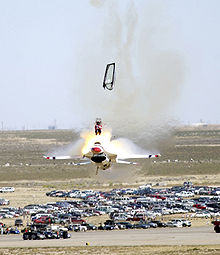 Then the chute snaps open — much too quickly — jolting me back to real time and short-circuiting the transition from stark terror to giddy elation, the evil Siamese twins of parachute jumping.
Then the chute snaps open — much too quickly — jolting me back to real time and short-circuiting the transition from stark terror to giddy elation, the evil Siamese twins of parachute jumping.
My helmet is missing. Where did it go? I look up and see a couple of torn chute panels, several snapped shroud lines and one large rip in the crown of the canopy. That means I’ll come down a bit quicker than necessary. But there’s not much altitude left anyway.
Going to land in the infield, near show-center. Have to figure out the wind, get the chute collapsed fast so as not to be dragged along. Heck! On the ground and being dragged already. Focus on getting it collapsed! Finally, I stand up, thinking I’m in one piece. And here comes a blue van with some of our guys in it.
Then it begins to sink in. In 14 years and 1,000-plus air shows, the Thunderbirds Team has been clever enough to do all its metal-bending in preparation for the air shows and out of sight. This is our first accident in front of a crowd. And the honor is mine. I gather my gear and climb into the van. Somebody wants to take me immediately to the base hospital, but I say, “Let’s go over and tell the ground crew I’m OK.”
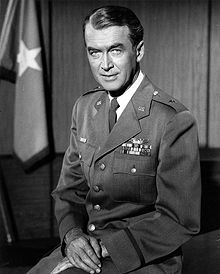 So we stop, I get out of the van, shake hands, toss the crew chiefs an insincere thumbs-up. Jimmy Stewart is still there and comes over to say nice things, but Raquel hasn’t stayed for the show, so no air-kiss. I’d given our narrator, Mike Miller, some ad-libbing lines to do in the middle of his presentation, and he stops to say maybe we should leave “that thing . . . whatever it was” . . . out of the air show sequence.
So we stop, I get out of the van, shake hands, toss the crew chiefs an insincere thumbs-up. Jimmy Stewart is still there and comes over to say nice things, but Raquel hasn’t stayed for the show, so no air-kiss. I’d given our narrator, Mike Miller, some ad-libbing lines to do in the middle of his presentation, and he stops to say maybe we should leave “that thing . . . whatever it was” . . . out of the air show sequence.
That’s when I learn I’d jerked the wings off the airplane.
On most modern fighters, the wings are well behind the pilot. You can see them in the rear view mirror or if you look back, but otherwise they’re not in your field of view. Of course, I had been watching the Diamond, ahead and well above me. I hadn’t seen the wings come off, but I knew it blew up.
The F-100 has a large fuel tank in the fuselage, on top of the wing center section and forward of the engine. When the wings folded, a large quantity of raw fuel from that tank dumped into the engine. Which exploded. The shock wave from the blast propagated up the air intake and blew the nose off, removing the first 6 feet of the airplane. The tail of the jet also was badly damaged, liberating the drag chute. As it came fluttering down, some in the crowd thought my personal parachute had failed.
After it exploded, the engine started pumping flames through the cockpit-pressurization lines. Conditioned air enters the cockpit at the pilot’s feet and also behind his head. My flying boots, ordinarily pretty shiny for an ROTC grad, were charred beyond repair. I never wore them again. Where I had rolled my collar inverted to protect its show-suit appearance, my neck got toasted by cockpit fire surging from the vents.
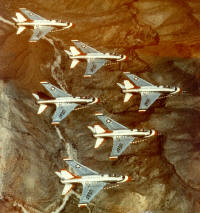 I have no idea how fast I was traveling at ejection. I was certainly barely subsonic when the wings failed. But with its nose blown off, the F-100 is a fairly blunt object and was slowing down quickly. On the other hand, I remained with the aircraft no more than a second or two after it exploded, so there wasn’t much time to decelerate.
I have no idea how fast I was traveling at ejection. I was certainly barely subsonic when the wings failed. But with its nose blown off, the F-100 is a fairly blunt object and was slowing down quickly. On the other hand, I remained with the aircraft no more than a second or two after it exploded, so there wasn’t much time to decelerate.
When I came out of the jet, wind blast caught my helmet, rotated it 90 degrees and ripped it off my head. It was found on the ground with the visor in the down position, oxygen mask still hooked up and chin strap still fastened. As the helmet rotated, it scuffed through the toasted skin on my neck, causing some bleeding.
The Team keeps a zero-delay parachute lanyard hooked up during the air show, giving us the quickest possible chute deployment. That explained why my chute opened fast. It was too fast. I didn’t get enough separation from the seat, and it touched my deploying canopy, causing the large tear in the parachute’s fabric. The immediate, high-speed opening was certainly harsher than normal, and as my torso whipped around to align with the chute risers, the heavy straps did further damage to my burned neck.
Walking into the base hospital, I’m startled by my image in a full-length mirror. Above, a sign says: “Check Your Military Appearance.” Mine looks like I’ve crawled into a burlap bag with a mountain lion. The white show suit is a goner, the cockpit fire having given it a base-coat of charcoal gray accented by blood and a final dressing of dirt, grass and Del Rio sagebrush stain. Being dragged along the ground accounted for the camouflage, but I hadn’t realized my neck was bleeding so much. I look like the main course in a slasher movie — “The Solo Pilot From Hell.”
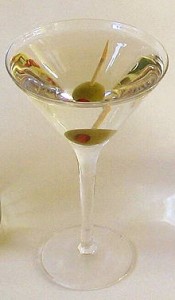
 They keep me in the hospital overnight. The Team visits, and Mike Miller smuggles in a dry martini in a second-hand milk carton. Everybody’s leaving for Nellis AFB the next morning. I tell the hospital staff I’m leaving, too, and ask our Slotman, Jack Dickey, to pack my stuff at the motel. The 1967 show season is over.
They keep me in the hospital overnight. The Team visits, and Mike Miller smuggles in a dry martini in a second-hand milk carton. Everybody’s leaving for Nellis AFB the next morning. I tell the hospital staff I’m leaving, too, and ask our Slotman, Jack Dickey, to pack my stuff at the motel. The 1967 show season is over.
After I leaped out, my aircraft continued on a ballistic trajectory, scattering parts and equipment along the extended flight path. Most of the engine and the main fuselage section impacted about 2 miles away from my initial pull-up over air show center. All the bits and pieces landed on government soil, and there was no injury or property damage. My aircraft was destroyed — I signed a hand-receipt for $696,989. On the other hand, if there is a good kind of accident, this was the one. Nobody was hurt, and all the scrap metal was collected for post-game analysis.
The F-100’s wings mate into a box at the center of the fuselage, the strongest part of the airplane. When my aircraft’s wing center box was inspected, it was found to have failed. North American Rockwell, the manufacturer, tested the box on a bend-and-stretch machine, and it broke again at an equivalent load of 6.5 G for my flight condition when the wings departed.
It shouldn’t have happened, since the F-100’s positive load limit is 7.33 G, but my F-100’s wing center box broke along a fatigue crack. And there were about thirty more cracks in the vicinity.
Some then-recent F-100 losses in Vietnam looked suspiciously similar. The recovery from a dive-bomb pass is a lot like my high-speed, high-G pull-up into the Bomb Burst. In the Vietnam accidents, the pieces had not been recovered, and the aircraft were written off as combat losses.
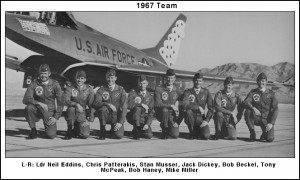 Later, specialists discovered considerable fatigue damage in the wing center boxes of other Thunderbird aircraft. USAF immediately put a 4 G limit on the F-100 and initiated a program to run all the aircraft through depot modification to beef up the wing center box. My accident almost certainly saved lives by revealing a serious problem in the F-100 fleet.
Later, specialists discovered considerable fatigue damage in the wing center boxes of other Thunderbird aircraft. USAF immediately put a 4 G limit on the F-100 and initiated a program to run all the aircraft through depot modification to beef up the wing center box. My accident almost certainly saved lives by revealing a serious problem in the F-100 fleet.


